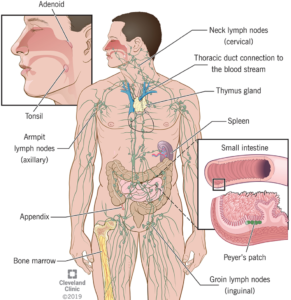The lymphatic system plays a key role in waste removal and immune function. Until 2012 it was thought that not such waste removal system existed in the brain. Turns out astrocytes facilitate this job.
The lymphatic system plays a key role in the body of removing waste including various metabolic waster products, accumulations of soluble proteins and excess interstitial fluid. It consists of a network of lymphatic capillaries, nodes and ducts that move lymph, a clear fluid filled with waste out of tissues, filters them and returns the fluid into the blood stream. Also part of the lymphatic system are the spleen and thymus that produce white blood cells and play a key role in immune defense.
Mysteriously, as you will notice in the image below, the lymphatic system stops at the neck. What about the brain? Surely the brain too needs a system of waste removal to function effectively. However, anatomically no lymphatic vessels had been found and until recently it was thought that there was no lymphatic system in the brain. Instead, waste removal was thought to occur by some kind of degradation process.
An astrocyte-based clearance or glymphatic system
Turns out a lymphatic system very much exists in the brain – it just looks different. In the brain the lymphatic function is carried out by astrocytes, a common type of glial cell in what has been termed the ‘glymphatic system’ [1]. The feet of these astrocytes wrap around the vasculature in the brain and express a channel aquaporin-4 which allows the astrocytes to move CSF into the brain along arterial perivascular space and into the interstitial space of brain tissue and then into the venous perivascular and perineuronal spaces, cleaning solutes from the neuropil into meningeal and cervical lymphatic drainage vessels.
This discovery was first made in 2012 by the Nedergaard lab by injecting tracers into the CSF of mice and imaging them with two-photon microscopy to track the rate of movement and clearance of different sized molecules. These molecules were found to readily move through the para-arterial space and exit at the para-venous space at rates that were sever 100-fold faster than the rate of diffusion which suggested an active process of removal. Astrocytes as key players was discovered using transgenic mice that lacked aquaporin-4 where a 70 percent reduction was found in the clearance of large solutes, such as Amyloid-β, the accumulation of which is a key hallmark of Alzheimer’s dementia. This is, however, still a subject of some debate.
Several features of the glymphatic and meningeal lymphatic systems have been shown to be present in humans. Contrast MRI method have been used to show that CSF flows along pathways that closely resemble the glymphatic system described in rodents. However, glia in humans differ substantially different from glia in rodents in terms of size and gene expression and certain functional characteristics. Nonetheless, human astrocytes also have polarized aquaporin-4 expression on their end feet. However, research is still needed to confirm whether specific factors driving glymphatic flow in rodents also apply to humans.
Active when you sleep
One key aspect of the glymphatic system is that it is predominantly active during sleep [2]. Here the clearance of harmful metabolites such as amyloid β (Aβ) increases two-fold relative to the waking state. Furthermore, PET studies have revealed that Aβ accumulates in the healthy human brain after just a single night of sleep deprivation, suggesting that the human glymphatic pathway might also be primarily active during sleep. Amyloid B is only one metabolite of hundreds. The general lack of effective removal of waste could be behind a poor night’s sleep and a cause of various types of mental and neurological dysfunction. We have long known that sleep is important for the brain. This may be one major reason why. It makes sense that waste removal needs the main activity of the brain to be shut off perhaps similar to why cleaning our streets and moving out garbage typically takes place when most are asleep to avoid the day time traffic.
See related post The Mental Health Profiles of the Sedentary and Sleep Deprived.
The glymphatic system and neurological and mental health disorders
The best studied example is that of Amyloid β and Alzheimers disease. PET studies in humans have shown that CSF clearance of Aβ and tau tracers is reduced in those with Alzheimer’s disease compared with healthy controls. The reduction in CSF clearance was also associated with increasing grey-matter concentrations of Aβ in the human brain. Others have recently developed a protocol to collect brain lymphatic fluid from the afferent lymphatic vessels of deep cervical lymph nodes (dcLNs) showing that it contains far more metabolites than CSF [3]. This raises interesting possibilities of BLF as a sensitive indicator pathological conditions. Having a good way to measure metabolites in the brain lymphatic fluid can be tremendously useful in establishing links to brain dynamics and disordered outcomes.
References
[1] Rasmussen et al., The glymphatic pathway in neurological disorders Lancet Neurol. 2018 Nov;17(11):1016-1024.
[2] Xie L, et al. Sleep drives metabolite clearance from the adult brain. Science 2013; 342(6156): 373–7.
[3] He W. et al., The anatomy and metabolome of the lymphatic system in the brain in health and disease Brain Pathology 2019 Nov



















